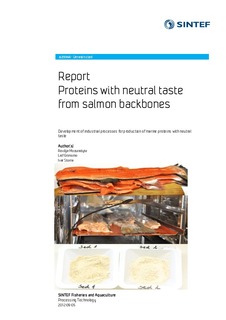| dc.contributor.author | Mozuraityte, Revilija | |
| dc.contributor.author | Grimsmo, Leif | |
| dc.contributor.author | Storrø, Ivar | |
| dc.date.accessioned | 2017-12-27T08:44:22Z | |
| dc.date.available | 2017-12-27T08:44:22Z | |
| dc.date.created | 2017-12-22T09:48:11Z | |
| dc.date.issued | 2012-09-05 | |
| dc.identifier.isbn | 978-82-14-05450-7 | |
| dc.identifier.uri | http://hdl.handle.net/11250/2473760 | |
| dc.description.abstract | The main goal in this project is to find an economic and profitable technology for production of '"tasteless·· fish proteins from salmon backbones. Two possible sources/technologies for the isolation of the proteins are evaluated in the project: the solid phase from salmon oil production and a process with cooking of salmon backbones before bone separation. The process where the salmon backbones were cooked before separation (the continuous cooker process) gave the highest product yield. In order to be able to produce tasteless fish proteins with a low amount of lipids, the applied shear forces should be reduced to a minimum throughout the process, as this will make the removal of lipid more efficient.
Preliminary sensory analyses show that the produced fish proteins powders taste intensity is in the same range as that of soya isolates, a common commercial product, sold in large volumes. However, taste panellists usually recognize Fish proteins to be fish. Therefore, the use of masking taste compounds could be evaluated. Preliminary sensory results also indicated that taste of the protein powders was not affected by the amount of lipids in the studied samples. This is an important finding, since it opens the door for a simpler, more cost effective process.The type of meat, red or whole meat, used for isolation of proteins could not be distinguished by sensory panellists. Further work should clarify the importance of the lipid content and the stability of these protein powders.
A preliminary economic analysis of the two processes shows that the band cooking process has the highest potential to succeed due to higher yield of protein from the back bones. Based on a raw material price on 2 NOK/kg, crude marine oil NOK 4/kg and on 80 NOK/kg for produced protein powder ethanol extracted protein powder give a net cash flow of 0. 78 mill NDK for a process based on roughly 2000 tons/year of salmon backbones. If ethanol extraction can be omitted the net cash flow is 12 mill NOK.
A further stability test on the produced protein powders with accompanying sensory tests are recommended, such study could indicate the potential marked segments for these products. | nb_NO |
| dc.description.sponsorship | Fiskeri og havbruksnæringens forskingsfond | nb_NO |
| dc.language.iso | mis | nb_NO |
| dc.publisher | SINTEF Fiskeri og havbruk | nb_NO |
| dc.relation.ispartofseries | SINTEF Fiskeri og havbruk rapporter;A23364 | |
| dc.rights | Attribution-NonCommercial-NoDerivatives 4.0 Internasjonal | * |
| dc.rights.uri | http://creativecommons.org/licenses/by-nc-nd/4.0/deed.no | * |
| dc.subject | By-products | nb_NO |
| dc.subject | Salmon | nb_NO |
| dc.subject | Processing | nb_NO |
| dc.subject | Profitable | nb_NO |
| dc.title | Proteins with neutral taste from salmon backbones | nb_NO |
| dc.type | Research report | nb_NO |
| dc.description.version | publishedVersion | nb_NO |
| dc.rights.holder | SINTEF Ocean | nb_NO |
| dc.source.pagenumber | 23 | nb_NO |
| dc.identifier.cristin | 1531347 | |
| cristin.unitcode | 7566,5,0,0 | |
| cristin.unitname | Prosessteknologi | |
| cristin.ispublished | true | |
| cristin.fulltext | original | |

